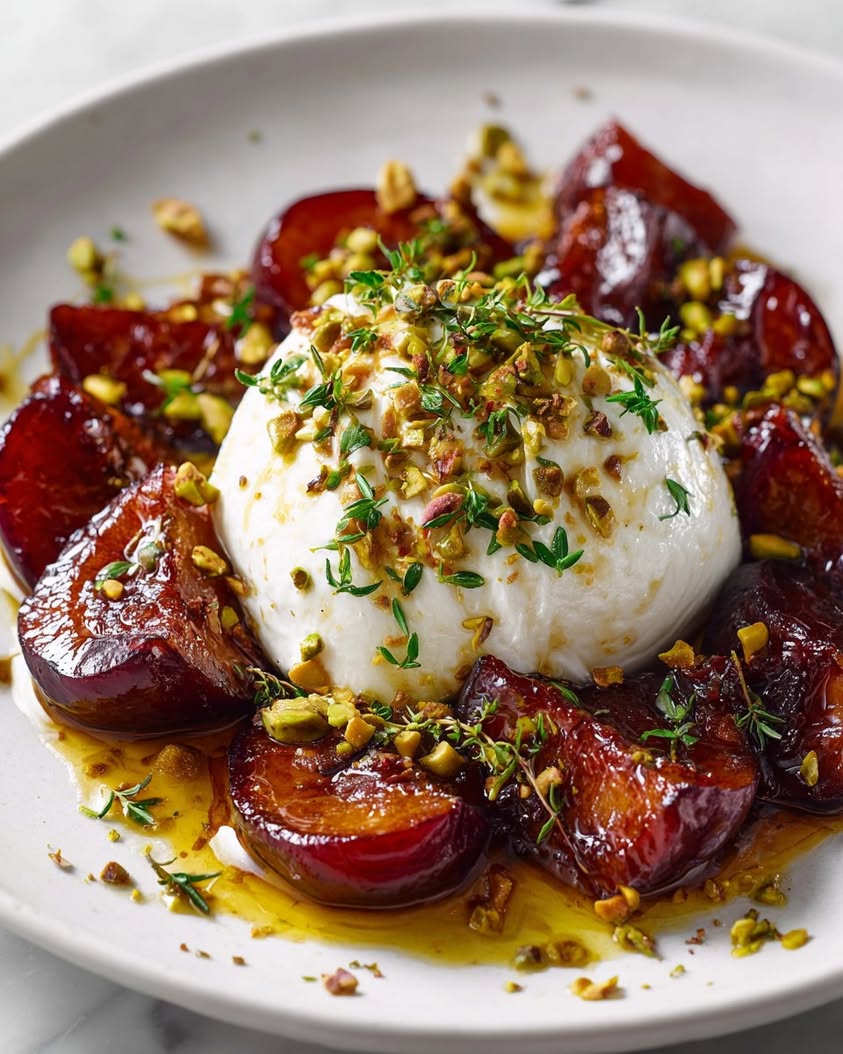Golden Hour Burrata Bliss: A Sweet-Savory Summer Showstopper
Golden Hour Burrata Bliss transforms simple ingredients into an unforgettable summer dish. Imagine creamy burrata cheese paired with caramelized roasted plums, all drizzled with honey and fresh herbs. This recipe delivers a perfect balance of sweet and savory flavors that will impress any guest. Moreover, it requires minimal effort for maximum impact, making it ideal for both weeknight dinners and special occasions.
The magic happens when the plums roast to jammy perfection, their natural sugars intensifying under heat. Meanwhile, the burrata provides a cool, creamy contrast that melts in your mouth. Fresh herbs add brightness, while nuts contribute welcome crunch. Best of all, this dish looks as stunning as it tastes, with vibrant colors that evoke golden hour sunlight. Whether served as an appetizer or light main course, it promises to become a seasonal favorite.
Quick Recipe Highlights
- Flavor Profile: Sweet roasted plums meet creamy burrata with herbal and nutty accents. The honey drizzle ties everything together with floral sweetness.
- Texture: Contrasts abound from the silky cheese to jammy fruit and crunchy nuts. Each bite offers multiple satisfying mouthfeels.
- Aroma: Warm plum fragrance mingles with fresh basil and toasted nuts. The scent alone will draw people to your table.
- Visual Appeal: Golden plums against white cheese create striking color contrast. Garnishes add pops of green and brown for Instagram-worthy presentation.
- Skill Level Needed: Requires basic roasting and assembly skills. Perfect for beginners looking to impress.
- Special Equipment: Just a baking sheet and oven. No fancy tools required.
Recipe Overview
- Difficulty Level: This recipe earns its easy rating through simple techniques and forgiving ingredients. Even first-timers can achieve excellent results.
- Category: Functions equally well as an appetizer, light lunch, or sophisticated side dish. Versatility makes it a valuable addition to any cook’s repertoire.
- Cuisine: Draws inspiration from Italian cheese traditions and modern California cuisine. The combination celebrates seasonal produce with European techniques.
- Cost: Uses affordable seasonal fruit and one luxury ingredient (burrata). Overall remains budget-friendly for special occasions.
- Season: Perfect for late summer when plums peak. Also works with autumn stone fruit varieties.
- Occasion: Equally at home at casual gatherings and formal dinners. Adapts beautifully to picnics when transported carefully.
Why You’ll Love This Golden Hour Burrata Bliss
The taste experience begins with the initial visual appeal of golden plums nestled against creamy white burrata. First bites deliver an exciting contrast between warm fruit and cool cheese. Furthermore, the honey enhances the plums’ natural sweetness without overwhelming the savory elements. Fresh herbs cut through the richness, while nuts provide satisfying textural counterpoints.
Preparation couldn’t be simpler for such an impressive result. Roasting requires minimal hands-on time, allowing you to focus on other meal components. Additionally, the dish comes together quickly once the plums finish cooking. This makes it ideal for last-minute entertaining or busy weeknights when you want something special without fuss.
Nutritionally, this recipe offers a balanced mix of protein, healthy fats, and fruit-based vitamins. Burrata provides calcium and protein, while plums contribute fiber and antioxidants. Nuts add beneficial plant-based fats. Together they create a satisfying dish that feels indulgent while delivering real nutritional value.
Entertaining value shines through the dish’s versatility and visual drama. Guests will marvel at the beautiful presentation and complex flavors. Moreover, it serves as an excellent conversation starter about seasonal ingredients and simple gourmet cooking. The recipe scales easily for larger groups without losing its impact.
Cost-effectiveness comes from using one premium ingredient (burrata) to elevate affordable seasonal produce. A single ball of cheese stretches across multiple servings when paired with plentiful fruit. This approach makes gourmet flavors accessible for everyday meals rather than reserving them for special occasions.
Historical Background and Cultural Significance
Burrata’s origins trace back to early 20th century Puglia, Italy, where cheesemakers developed this luxurious variation on fresh mozzarella. The technique involves forming a pouch of stretched curd filled with cream and cheese scraps. This innovation transformed surplus ingredients into a premium product. Today, artisanal producers worldwide craft their versions of this creamy specialty.
Plums have graced tables since ancient times, with evidence of cultivation dating back thousands of years. Various cultures prized them for their sweetness and preservation potential. Roasting fruit emerged as a technique to concentrate flavors before modern sweeteners became widely available. Combining fruit with cheese appears across European culinary traditions, from French tartines to Italian dessert courses.
The modern trend of pairing burrata with seasonal fruit reflects contemporary dining preferences for simple, high-quality ingredients. California cuisine particularly embraced this approach, showcasing perfect produce with minimal manipulation. Our recipe builds on this tradition while adding textural elements for greater complexity.
Regional variations might include different stone fruits based on local availability. Some versions incorporate balsamic glaze instead of honey, while others add spicy elements like chili flakes. The basic template welcomes creativity while maintaining its essential balance of creamy, sweet, and savory components.
Ingredient Deep Dive
Burrata begins as fresh mozzarella before receiving its signature creamy center. The outer shell should feel firm but yielding, while the interior remains lusciously soft. When selecting, look for balls floating in whey or water, which indicates freshness. Avoid any with sour odors or discolored liquid. Store submerged in its liquid in the coldest part of your refrigerator for up to three days.
Plums for roasting should be ripe but firm, yielding slightly to gentle pressure. Varieties with red or golden flesh work beautifully here. Underripe fruit won’t develop sufficient sweetness, while overripe specimens may turn mushy. Look for unblemished skins and fragrant stems. Store at room temperature until perfectly ripe, then refrigerate to extend usability.
Honey selection dramatically impacts the final flavor profile. Light floral varieties like orange blossom or acacia keep the focus on the fruit. Darker honeys like buckwheat add more robust notes. Raw honey offers beneficial enzymes and more complex flavors than processed versions. Always taste your honey before using to understand its particular characteristics.
Common Mistakes to Avoid
- Overcooking plums turns them to mush. Remove from oven when slightly softened but still holding shape.
- Skipping the resting time for roasted fruit prevents proper syrup development. Allow at least five minutes before assembling.
- Using cold burrata straight from fridge dulls flavors. Let it sit at room temperature for fifteen minutes before serving.
- Overhandling burrata breaks the delicate outer skin. Tear gently rather than cutting for best presentation.
- Neglecting to toast nuts leaves them tasting raw and bland. A quick toast maximizes flavor and crunch.
- Drizzling honey too early causes it to disappear into the dish. Add just before serving for maximum impact.
- Choosing inferior olive oil diminishes the final result. Use a fruity, fresh extra virgin variety.
- Overcrowding the baking sheet steams rather than roasts the fruit. Leave space between plum halves.
Essential Techniques
Roasting fruit requires attention to temperature and timing. Medium heat allows sugars to caramelize without burning. The plums should soften enough to yield to a spoon but retain some structural integrity. Watch for juices bubbling around the edges as a visual cue for doneness. If juices evaporate completely, the fruit may become dry.
Burrata handling demands gentle precision. First, drain the cheese thoroughly to prevent watery plates. Then, use your hands or a spoon to create rough, organic-looking pieces. The torn edges catch herbs and nuts beautifully. For dramatic presentation, place the whole ball on the platter and let guests break into it themselves.
Pro Tips for Perfect Golden Hour Burrata Bliss
- Roast plums on parchment paper for easy cleanup and to prevent sticking.
- Add a pinch of flaky salt to the honey drizzle to balance sweetness.
- Combine multiple herb varieties like basil, mint, and thyme for complexity.
- Toast nuts in a dry pan until fragrant for maximum flavor impact.
- Serve with crusty bread to soak up all the delicious juices.
- Add a sprinkle of chili flakes for those who enjoy subtle heat.
- Use black plums for deeper color contrast against the white cheese.
- Prepare components ahead and assemble just before serving for best texture.
Variations and Adaptations
For winter versions, try roasted pears or figs instead of plums. These fruits maintain the sweet-savory balance while accommodating colder months. Dried fruit like apricots or cherries can supplement fresh options when necessary. Simply rehydrate briefly in warm water before roasting.
Dietary adaptations include vegan versions using plant-based burrata alternatives. Many specialty stores now carry nut-based cheeses that mimic the creamy texture. For nut allergies, substitute toasted seeds like pumpkin or sunflower. Gluten-free needs are naturally accommodated in this recipe.
Serving and Presentation Guide
Presentation options range from rustic family-style platters to elegant individual portions. For gatherings, arrange the burrata in the center surrounded by plum halves. Drizzle honey in artistic swirls across the composition. Alternatively, compose individual plates with careful placement of each element.
Garnishes should enhance without overwhelming. Microgreens add delicate texture, while edible flowers provide dramatic flair. Consider the color wheel when selecting accompaniments – purple basil or red-veined sorrel make particularly striking contrasts. Always add delicate herbs last to prevent wilting.
Wine and Beverage Pairing
White wines with stone fruit notes complement the dish beautifully. Try an off-dry Riesling or Viognier to mirror the plums’ flavors. For red lovers, a light Pinot Noir won’t overwhelm the delicate cheese. Sparkling options add celebratory flair while cutting through richness.
Non-alcoholic pairings might include floral iced teas or fruit-infused sparkling water. The sweetness of peach or pear juice echoes the roasted fruit elements. For coffee pairings, choose a medium roast with stone fruit tasting notes.
Storage and Shelf Life
Assembled dishes should be enjoyed immediately for best texture. However, components store well separately for up to three days. Keep roasted plums refrigerated in an airtight container. Burrata must stay in its liquid until ready to use. Reheat plums gently before serving if desired.
Frequently Asked Questions
Can I use other stone fruits? Absolutely. Peaches, nectarines, or apricots all work beautifully when in season. Adjust roasting times based on fruit size and ripeness.
What if I can’t find burrata? Fresh mozzarella makes an acceptable substitute, though you’ll miss the creamy center. Consider adding a dollop of ricotta for similar richness.
How do I know when plums are perfectly roasted? The skins will wrinkle slightly and juices will bubble around the edges. They should yield to gentle pressure but not collapse.
Can I prepare this ahead for a party? Yes, roast the plums up to a day in advance and store refrigerated. Bring to room temperature before assembling with fresh burrata.
What nuts work best? Pistachios offer beautiful color, while walnuts provide earthiness. Almonds or hazelnuts also work well. Toast any choice for maximum flavor.
Golden Hour Burrata Bliss
Description
Creamy burrata meets sweet roasted plums in a nutty, herbal embrace. A plate that tastes like summer.
Ingredients
For the Crust:
- 2 ripe plums, sliced
- 8 oz burrata cheese
- 2 tbsp honey
- 1/4 cup toasted walnuts, chopped
- 1 tbsp fresh thyme leaves
- 1 tbsp olive oil
- 1/2 tsp sea salt
- 1/4 tsp black pepper
- 1 baguette, sliced and toasted
Instructions
1. Prepare the Crust:
- Preheat oven to 375°F (190°C). Arrange plum slices on a baking sheet, drizzle with 1 tbsp honey, and roast for 15 minutes until softened.
- Place burrata on a serving plate. Gently tear open the burrata to expose the creamy center.
- Arrange roasted plums around the burrata. Drizzle with remaining honey and olive oil. Sprinkle with walnuts, thyme, salt, and pepper.
- Serve immediately with toasted baguette slices for scooping.
Notes
You can customize the seasonings to taste.
I’m Shaykee—born in Morocco, seasoned across continents. From airplane galleys to home kitchens, I share the flavors and stories that shaped my journey.

